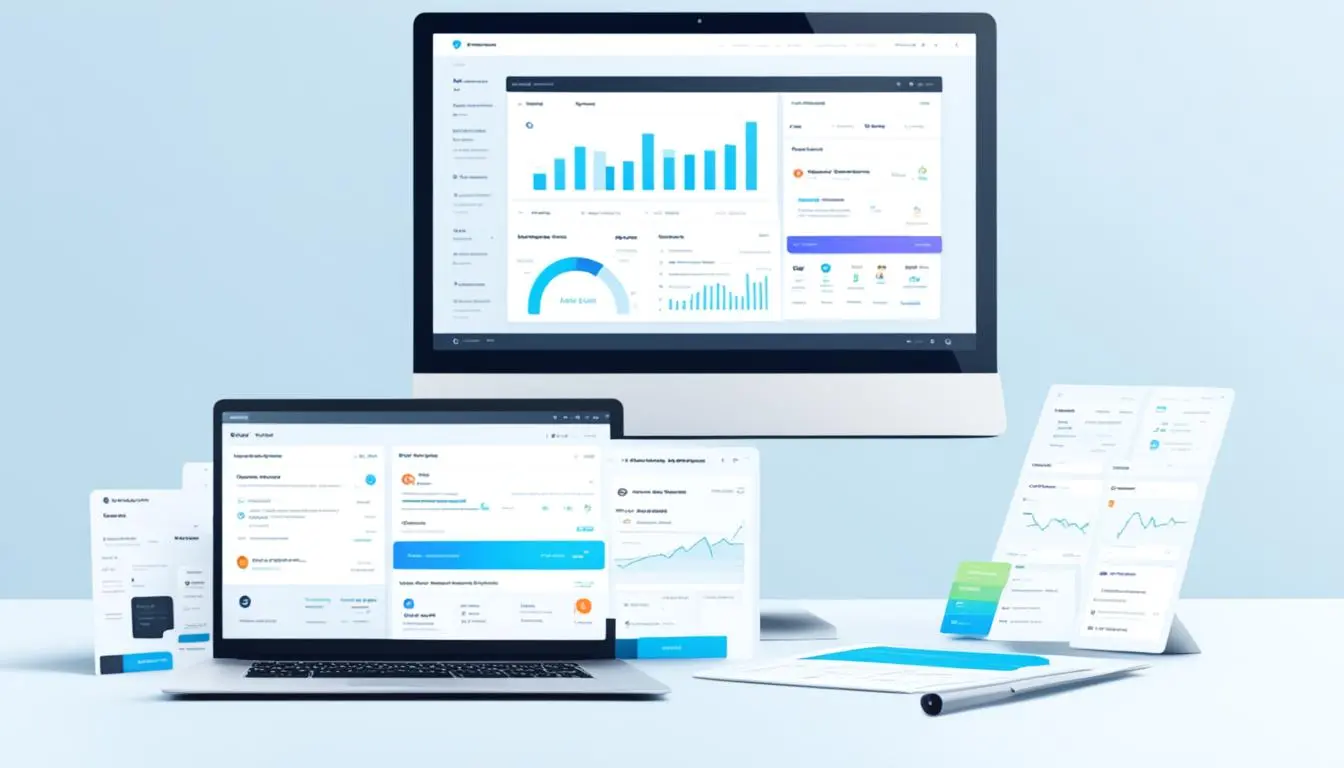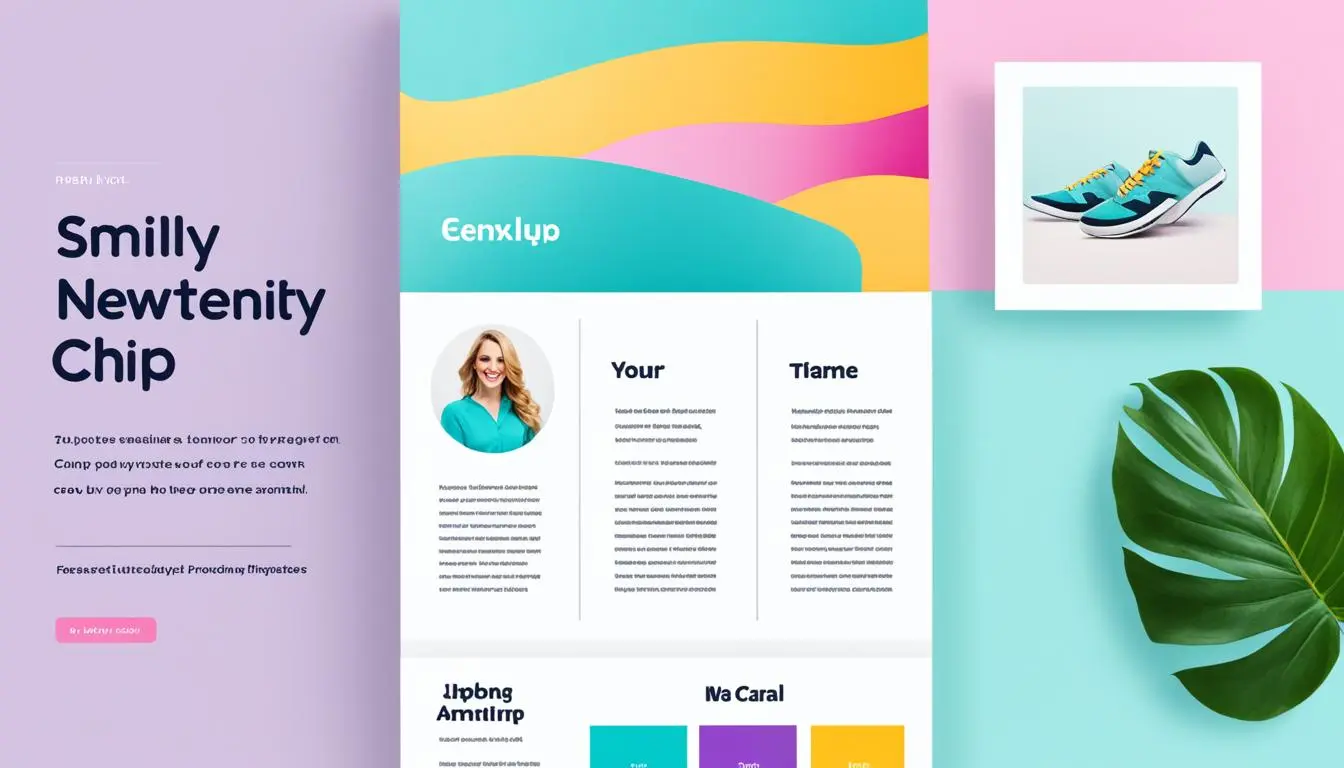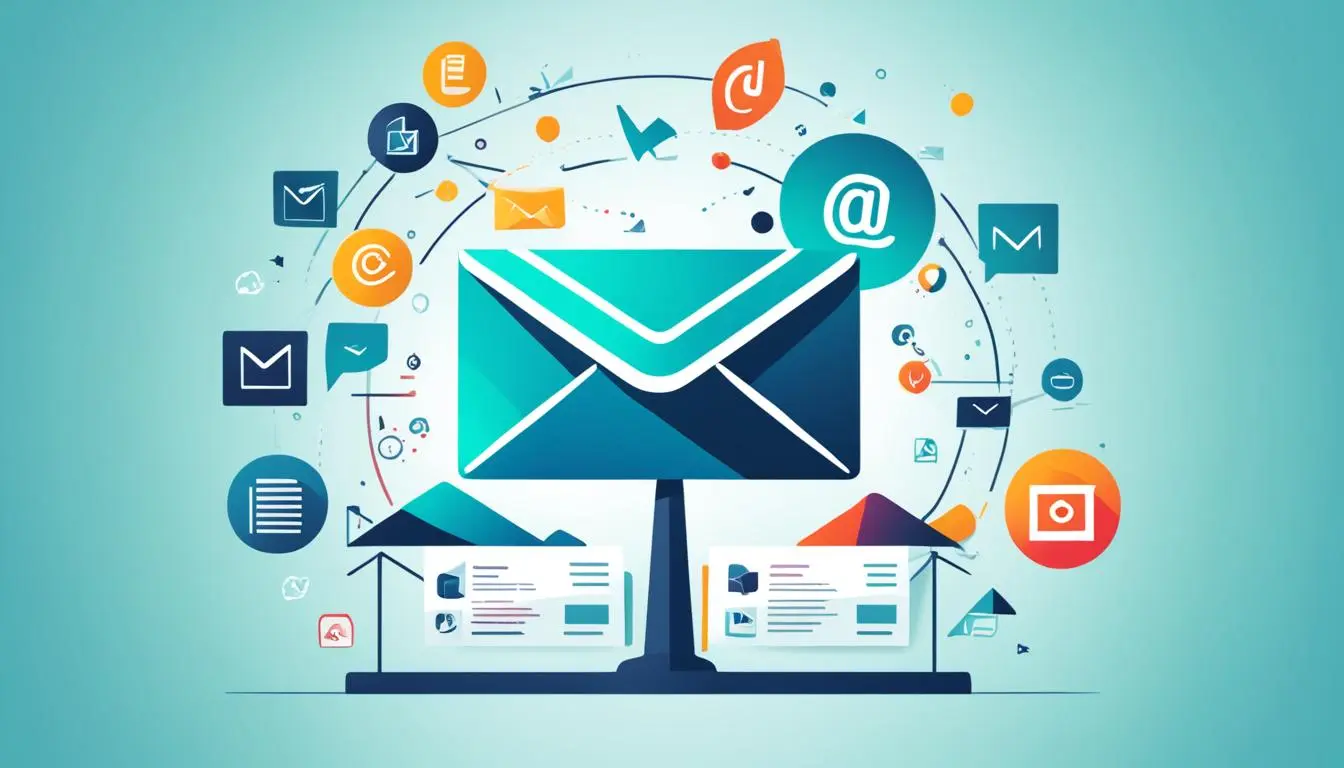Ever looked at your inbox and seen brands fighting for your attention? It’s all about email marketing. For every dollar spent, it earns an average of $361. Want to be one of the successful businesses, not just another swipe away? Learn key strategies for boosting your email campaigns’ success.
Email marketing’s power in the digital age is clear. Yet, success takes more than just sending emails. Setting clear goals and crafting catchy subject lines are crucial1. Make use of email automation and smart segmentation to stand out. This way, your emails become personal and memorable, not lost in a sea of digital clutter2.
But that’s not all. Strong content and managing your email list is important, as is using smart analytics12. Make sure your emails are mobile-friendly. This ensures they’re not just read, but they prompt action. Keeping up with the latest email trends and improving your conversion rates is key to staying ahead.
Key Takeaways
- Attain a high ROI through succinct planning and captivating email subject lines.
- Personalize and segment campaigns to resonate with targeted audiences.
- Use email automation to streamline campaigns and foster consistent engagement.
- Choose email marketing platforms that offer robust analytics and integration features.
- Understand mobile responsiveness as a vital factor for successful email campaigns.
- Legal considerations and deliverability best practices secure both trust and open rates.
Understanding Email Marketing and Its Expansive Impact
Email marketing is an essential part of today’s digital strategies. It focuses on making emails personal, getting them to the right people, boosting how many people act on them, and sending different messages to different groups. It’s about more than just speaking to a lot of people. It’s about making each message hit home by talking about what’s important to them.
Recent studies show that 87% of marketers think email marketing is key to doing well3. They also say that by 2024, there could be 4.48 billion email users3. This shows how widely used email is for getting your product known and selling more. Email’s big because for every dollar you spend, you get $36 back (by 2022)3. This proves its value as a tool for businesses, especially due to its very good return on investment. It helps companies build real relationships with their customers. This leads to healthy, back-and-forth conversations.
- Email Personalization: Making emails that fit what certain people like makes them more likely to read and do what the email wants them to do4.
- Email Deliverability: Getting emails to the right people without them getting blocked or lost is key to letting your voice be heard.
- Email Conversion Optimization: Getting potential customers to actually do something, like buy a product online, by making emails look and say the right things.
- Email Segmentation: Sending the right info to the right group of people can make them more interested and likely to act4.
Email marketing is growing bigger. New tech and smarter ways of sending emails are becoming more and more important. Email automation is a perfect example. It cuts down on the work needed to keep in touch with customers, but it also keeps them more involved. This gives companies a big edge in how they handle a large number of email talks with people4. Using tools that look at what’s working in real time helps companies act quickly to make emails better and more effective4.
Email marketing is key for lots of industries. Each industry has to think about it in its own way to get the best results. Plenty of e-commerce companies, for example, want to use email to make their brand better known first3. This shows the wide use of email marketing. It’s used in everything, from talking directly to buyers to making a big name for a brand.
It’s important to choose the right tools for email marketing. Platforms like HubSpot and Maropost are great because they help you send emails at scale that still feel personal. They also help get your emails to the right place and keep people interested in what you’re saying.
Email marketing is very direct. It calls for people to take action, but it also opens big chances for brands to really connect with their audience. With the right way of sending emails, every email you send could lead to a big jump in business. You just have to be smart about what you send and to whom.
The Importance of Creating Engaging Opt-in Forms
The heart of generating leads through emails lies in the design and location of opt-in forms. Well-designed opt-in forms not only attract subscribers but act as the start of a lasting relationship.
Designing Opt-in Forms to Maximize Subscriber Growth
Maximizing subscriber growth depends on the opt-in form design. A clear and appealing form that shows the subscriber’s benefits increases the visitor’s likelihood to join. It’s also key to incorporate preferences right at the sign-up stage to create more relevant email content, reducing fall-offs and boosting engagement5.
Link in bio from Flodesk shows how social media and opt-ins can work together to improve lead generation. This method can increase the rate of building your list from social media by 40 times over conventional forms5.
Optimizing Form Placement for Increased Conversion
The position of opt-in forms is vital to reduce barriers to joining. They should be clearly visible on your site’s main pages and articles to increase sign-up chances. Customizing these forms based on a user’s site interaction can also make your emails more successful5,6.
Art of Crafting a Compelling Call-to-Action
The call-to-action (CTA) is crucial for turning visitors into subscribers. The CTA should be both appealing and offer clear value to the audience. Including GDPR compliance with an easy opt-out builds trust, reducing spam reports5,6.
| Opt-in Feature | Benefits | Impact on Conversion |
|---|---|---|
| Single Opt-in | Quicker signup process | Potentially higher unsubscribes5 |
| Double Opt-in | Confirms subscriber interest5 | Less likely to mark emails as spam5 |
| Personalized CTA | Increases relevance and engagement6 | Higher conversion rates |
Regularly cleaning your email lists every three to six months is critical. This activity keeps your email marketing strong and helps in robust lead generation and conversion optimization5.
Segmenting Your Subscribers for Personalized Communication
Dividing your email list into segments, and customizing emails for each segment, gives you lots of ways to connect with your audience better. This means you can send emails with content that really strikes a chord with different groups. As a result, your readers are more likely to respond and buy what you’re selling.
Criteria for Effective Audience Segmentation
Segmenting your audience right starts with looking at who they are, where they are, and what they do. 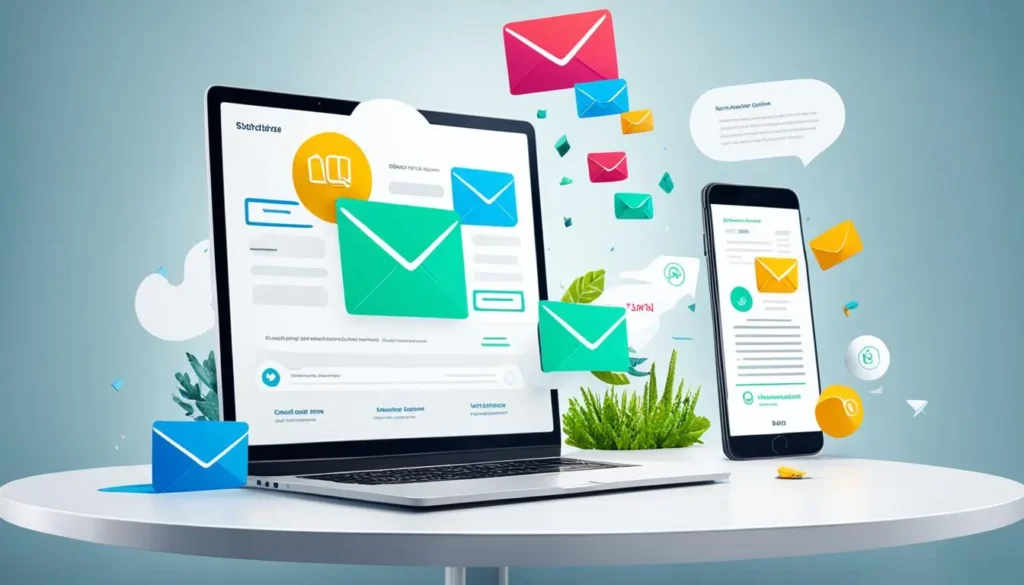 This process uses info like their age, gender, and how much money they make to make emails that speak directly to different kinds of people7. When you also sort by where they live, it makes your marketing even sharper, especially for selling to people all around the world7.
This process uses info like their age, gender, and how much money they make to make emails that speak directly to different kinds of people7. When you also sort by where they live, it makes your marketing even sharper, especially for selling to people all around the world7.
Implementing Segmentation Strategies
To nail your segmentation, get to know your customers’ online habits and what they’ve bought before. Looking at their online actions can boost your emails with product suggestions that are spot-on7. Knowing where they are in the buying process also helps tailor your messages. This moves them closer to a purchase7. Measuring how they interact with your emails also lets you make smarter follow-ups8.
Tools and Techniques for Segmenting Your Email List
The tools you pick can make or break how well you segment your emails. Using the right CRM or tools like Constant Contact, Drip, and OptinMonster can make managing your lists and sending the right emails smoother8. These options help with dividing your list based on things like what people do on your website or how they act when they get your emails. This makes your emails feel more personal and right on target8.
Connecting your segmentation with automation can level up your email game, letting you send the perfect message at just the right time without loads of manual work. This not only saves you time but also keeps your messaging on point and personal. It’s a win for you and your subscribers8.
Email Automation: Scaling Your Campaigns Efficiently
Email automation is key for strong marketing. It lets businesses send precise, targeted emails without much work. Tools like Twilio SendGrid’s Journeys can automatically send emails based on what users do. Using customers’ shopping habits makes selling more exact9.
When email software and website trackers work together, emails can react to site actions. This means you can catch customers’ interest at just the right moment. For instance, reminding them of an item left in their cart. Missing this chance could lead to big money lost, around $136 billion in the U.S. alone9.
Adding personal touches to emails is easier now. Personal emails, like welcome notes, are much more popular. They get opened 4 times more and get clicked 5 times more than regular emails. Tools like Twilio Engage offer deep insights on customers. Plus, they provide more than 400 links for a smooth experience across different channels9.
Email automation not only cuts time but also boosts how many people see and interact with your emails. It reacts fast to what customers do. This means sending out content that’s always interesting and timely, leading to better results with email actions.
To use email automation well, companies should focus on using strong systems for their customer data. This way, every email campaign can be set up exactly right for the most customer interest and sales. By being proactive and using advanced email tools, companies can grow their email marketing effectively while keeping things personal and interesting.
Crafting Catchy Email Subject Lines That Increase Open Rates
The first thing people see in an email is the subject line. It can make them open it or ignore it. You need to be good at writing subject lines to get more people to read your emails. This means being creative, personal, and choosing the right words carefully.
Elements of a Powerful Subject Line
A good subject line is short and clear. It makes the person reading it want to know more. Saying something is in limited supply, like “Limited Offer,” can make people open the email quickly. This kind of urgency makes them more likely to take action10. Also, adding the person’s name or things they like makes them more interested in the email11.
Testing and Optimization of Subject Lines
Testing different subject lines is key to figuring out what works. This helps match what you’re saying with what people want to hear. Each group of people might like different things, so by testing, you’ll learn what speaks to them10. For instance, trying out different versions of a subject line can tell you which words or styles work best11.
Subject Line Personalization Techniques
Personalizing emails is more important today than ever. Using data about someone or their past actions can make an email feel more direct. This can make people more likely to read and click through the email11. Ways to do this are by using the person’s name, talking about things they’ve bought before, or sending them content that fits their interests10.

By following these steps, you’ll not only make your emails better but also follow the best ways to talk to customers through email. It’s all about giving users a good experience and building strong relationships with them. As technology changes, so should the way we connect with people through email, using good subject lines to draw them in.
Email Personalization Beyond the First Name
Email personalization has gone further than just using a first name. Thanks to powerful data analysis, emails now offer a deeper connection. This means a better experience for you, aiming to get you more involved and possibly making purchases.
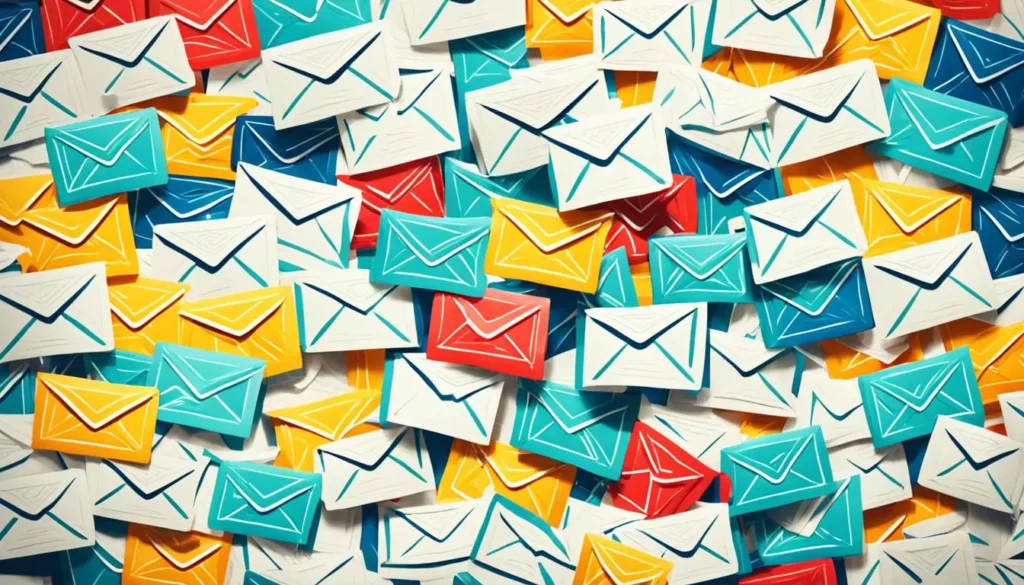
Brands like Amazon lead the way in personalizing emails. They look at what you’ve looked at, bought, and liked. This lets them send you emails that really fit your interests. Such emails make more people open them and often lead to more buying12.
Research shows how much good personal emails can do. They might increase sales by up to 760%1213. Also, little things like real comments or using your name in the ‘From’ line help grab your attention13.
“Email personalization is the key to better recipient engagement and maximizes the potential for conversions and revenue growth.”
Adding your own name or some special info to emails increases the chance of you opening them by 26%. This shows the power of small personal details in emails. It makes the emails more likely to catch your eye and create more interaction, which can lead to more sales1213.
Emails are also more effective when they focus on certain groups. But what really works is tailoring the content for individual customers. This way, the message remains relevant, keeping you interested in the brand.
These smart personalization tactics help companies stand out in crowded markets. By making every email feel unique, businesses can reach more people effectively. This approach beats sending the same email to everyone. It’s becoming the standard way to do email marketing well, delivering on customer needs and driving more sales.
Measuring Success with Email Analytics
Email analytics are crucial in digital marketing. They guide campaigns to top performance. Knowing how to use metrics can boost lead generation and email conversion optimization.
Key Performance Indicators to Monitor
Key email performance indicators like open and click-through rates are vital. Open rates show how many people open your emails, hinting at subject line appeal and list health14. Click-through rates reveal engagement by tracking link clicks14.
Conversion rates show how many complete a desired action14. These reflect the campaign’s true success. Unsubscribe rates help gauge satisfaction and find content or design issues14.
Benchmarking Your Campaign’s Performance
Comparing with industry standards and past efforts uncovers weak spots. Details like email timing’s impact on open rates are critical for success14. Tracking link performance informs content strategy changes to better fit what your audience likes14.
Using Analytics for Continuous Improvement
Continuous monitoring ensures email strategies stay effective and audience-focused. Metrics like open rates and CTRs help refine tactics for ongoing improvement14. They are key in building brand loyalty through continuous value delivery14.
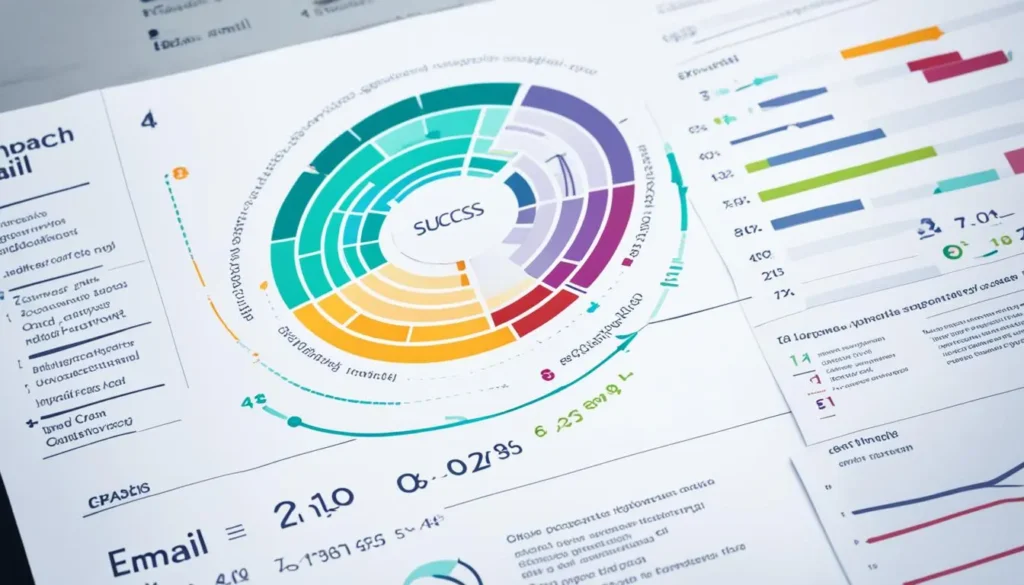
By applying these analytical methods, you can boost engagement and ROI. This step is crucial for business growth and lead generation success.
Email Marketing: Ensuring Mobile Responsiveness
In today’s world, getting your emails to people and making them personal is a big deal. This is especially true because many folks read emails on their phones.
Making your email look good on phones is crucial for keeping people interested and getting new leads. A big chunk of emails, 42 percent, are looked at on phones, showing this audience is key15. If your emails don’t look right on mobile, you could lose the interest of almost half your readers.
Ensuring that all email communications render correctly across various devices is not just a nicety—it’s a necessity.
We can make emails fit any-sized phone screen, thanks to tools like HubSpot. This means people are more likely to read and interact with your emails16. But, if your email is too big, Gmail might cut parts off, hurting how you’re seen and checked.
Emails are great for boosting sales. Soon, they could be making about 11 billion dollars worldwide every year15. That’s because for each dollar spent on emails, companies get back a lot more, between $45 to $5115.
| Consideration | Importance | Effect |
|---|---|---|
| Image File Size | High | Decreases load times, which could boost open rates by up to 80% without losing image quality16 |
| Text and CTA Button Size | Critical | Ensures ease of interactivity on mobile devices with a minimum recommended size of 57×57 pixels16. |
| Email Subject Line and Preview Text | Vital | Clear and concise messaging can prevent unintended text display, which helps in preventing miscommunication and potential brand damage17. |
Being clear and avoiding certain elements like helps make emails open and work right everywhere1. It's also good to use alt tags with images. This makes emails better for those who can't see the images and improves everyone's experience2.
Remember, making your emails personal and easy to read on all devices is key. It’s not just about sending them; it’s about getting people to engage with your message.
Staying Compliant with Email Marketing Regulations
Following email marketing laws is vital. It helps build trust and ensures your emails get delivered. Knowing these laws is key for any marketer, new or experienced. It ensures your campaigns will be successful.
Understanding CAN-SPAM Act Requirements
The CAN-SPAM Act requires businesses to clearly show who the email is from. Converse is a good example, always displaying their full name18. Breaking this law can cost you a lot, up to $50,120 for each violation19.
Data Privacy Laws and Email Marketing
GDPR is especially strict in email marketing. It mandates clear consent before using personal data. It also demands strong protection of data, even when it’s moving between countries19. Countries usually want you to label ads in emails, just like Sephora does18.
Best Practices for Consent and Unsubscribe Options
It’s crucial that users can easily opt out of emails. And any requests to unsubscribe must be handled quickly, in at most ten days, according to the CAN-SPAM laws18. A double opt-in can make your subscribers more engaged and is also a great legal move19.
By focusing on following these email marketing rules, you make each email count. This builds a good relationship between you and your readers. It’s about fostering trust and making your marketing more effective. Following these rules also protects your brand’s image and boosts your marketing strategy.
Conclusion: Email Marketing as a Powerful Revenue Driver
In the world of digital marketing, email marketing shines. It offers a huge ROI of 42:120. This big return comes from talking directly with people and sending messages that fit them just right. These tactics make stronger ties with customers, which boosts profits20. In today’s digital era, email marketing is key for any brand looking to grow.
By using tailor-made email campaigns and smart email segmentation, marketers can pull in a lot of web visitors. They catch the eyes of smartphone users, who love checking their emails20. Adding email automation to the mix brings easy interactions and boosts sales. It also allows for detailed checks on how emails do, like seeing who’s opening them and who’s not20.
Companies are always working to do better in reaching out to people. Making sure emails get delivered and then turn into actions is vital. Most people, about 72%, like hearing about deals and new stuff via email. Making emails more personal than just a name in the subject line really grabs attention. It makes email marketing a force in finding and winning over possible customers20. Exploring all that email marketing can do isn’t just smart. It’s necessary for businesses wanting to stand out in an online world that keeps getting busier.
FAQ
What are the key components of successful email campaigns?
Successful email campaigns use effective segmentation, personalization, and automation. They also have engaging subject lines and responsive designs. It’s crucial to follow regulations and use analytics for improvement. This helps boost conversion and deliverability.
How does email personalization impact the effectiveness of campaigns?
Email personalization boosts engagement, open rates, and conversions by tailoring messages to customer data. This goes beyond using names. It includes data on behavior and preferences for more meaningful messages.
What is email segmentation and why is it important?
Email segmentation divides subscriber lists based on certain criteria like behavior or interests. This allows for more tailored emails, boosting engagement and conversions. It makes your emails more relevant to different groups.
Why is mobile responsiveness crucial in email marketing?
Since more emails are opened on mobiles, a responsive design is crucial. It ensures emails look good and work well on all devices. This prevents frustration and keeps engagement high.
How can I improve my email deliverability rates?
To improve deliverability, prevent spam marking. Do this by getting consent, keeping your email list clean, and avoiding spam-like content. Testing your emails and monitoring analytics also help in spotting and fixing issues.
What is the significance of crafting an effective call-to-action in opt-in forms?
A good CTA in opt-in forms pushes potential subscribers to action. It starts the relationship with the subscriber, impacting lead generation and email success. It’s a key part of growing your email list.
How does email automation aid in scaling email marketing efforts?
Email automation sends emails at the right time based on actions or customer journey points. This removes the need for manual sending, letting you reach more customers with relevant messages. It boosts campaign success.
Why is it important to use email analytics for campaign optimization?
Email analytics reveal what’s working and what needs adjustment. The data helps in tweaking campaigns for better results. It’s essential for improving the campaign’s impact and return on investment.
What are the advantages of segmenting your email list?
Segmenting your email list means you can send information directly to specific groups. This makes messages more personalized and effective, increasing engagement and conversions. It improves your ability to reach your audience.
How do GDPR and other data privacy laws affect email marketing?
GDPR and data privacy laws control how you can use personal data. In email marketing, this means getting consent, offering easy unsubscribe, and keeping subscriber data safe. It helps build trust and ensures you’re following the law.
Source Links
- https://www.bluedoorsocial.com/post/maximize-your-reach-proven-email-marketing-strategies-for-2024
- https://www.wordstream.com/blog/ws/2021/07/01/email-marketing-tips
- https://blog.hubspot.com/marketing/email-marketing-guide
- https://elevatedmarketing.solutions/why-email-marketing-is-a-vital-marketing-strategy-to-your-success






